8 Best Crypto Research Tools 2024
Crypto is wild. You’ve got rug pulls, mystery project teams, and insane price swings. But there are also craaazy-good opportunities if you know where to look. How do you find the next winners? Well, you use crypto research tools, apps, and companies. The right analysis tools let you take a peek under the hood of cryptocurrencies and projects to see if they’re race-ready or crypto clunkers.
Here are our top picks.
Top Crypto Research Tools
- Messari: Best For Sector Performance Comparisons
- Dune: Best For Decentralized Finance (DeFi) Monitoring
- Glassnode: Best For Crypto Derivatives Traders
- Santiment: Best For Interactive Features
- IntoTheBlock: Best For Professional Traders
- Nansen: Best For Non-Fungible Tokens (NFTs)
- TradingView: Best For Newbies
- CryptoQuant: Best For Algorithmic Traders
| Platform | Price | No. of Supported Cryptocurrencies | Free Trial? |
|---|---|---|---|
| Messari | $29.99 per month for Pro version | 1,000+ | Yes |
| Dune | $420 to $1337 monthly | 100+ | Yes |
| Glassnode | $29 to $799 per month | 100+ | Yes |
| Santiment | $49 to $160 per month | 2,500+ | Yes |
| IntoTheBlock | Starting from $10 per month | 900+ | Yes |
| Nansen | $150 to $3000 per month | 500+ | No |
| TradingView | $15 to $60 per month | 300+ | Yes |
| CryptoQuant | $39 to $799 per month | 100+ | Yes |
1. Messari: Best For Sector Performance Comparisons
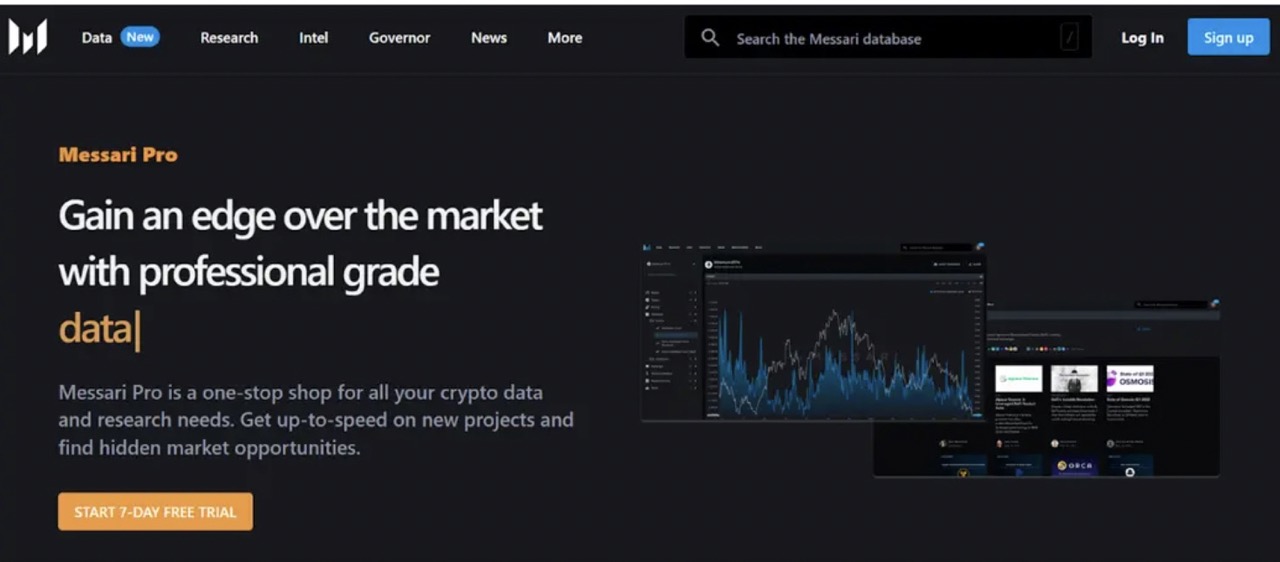
 Pros
Pros
- Free trial available
- Affordable Pro plan ($29.99 per month)
- Market screener and community screeners (Pro plan)
 Cons
Cons
- Limited free tier (charts only)
- Some research content only available with Enterprise plan
- Enterprise plan priced at $10,000 per year per seat
Key Features
Messari offers great data on the top projects and even some off the beaten path. But if you stray too far into the DeFi wilderness, you’re staring at an empty chart. For supported projects, Messari offers a wealth of information without digging. Charts, news, comparative performance, and more. Use the screener to build a research list.
- Charts: Messari shows you more than price action. You can track trading volume, volatility, or even the number of Telegram users and Twitter followers.
- Exclusive Research Content: Messari brings you research articles you won’t find anywhere else, deep dives into specific crypto ecosystems that identify strengths, weaknesses, competitors, and opportunities. Content varies by tier, with some content reserved for the Enterprise tier.
- Advanced Screener: You set the options and let Messari find the next gem. Fine-tune your criteria with over 175 metrics to find cryptos to research further.
Who Should Use It?
- People new to crypto trading: Messari works much like the stock screeners on popular brokerage websites. Some of the newer or lesser-known projects aren’t supported, which might be a good thing if you’re new to crypto. Less risky stuff, right?
- People who invest in top projects: Messari’s limitations in support for less-common cryptos may be a blessing in disguise. Less clutter. If you’re interested in crypto projects with more liquidity and an established market, consider Messari.
- Budget-conscious traders: At less than $30 per month for the Pro plan, Messari pairs a lot of value with a lower monthly bill. If you’re not a crypto whale yet but want to grow, you’ll find the tools to make the right picks to grow your stack wisely.
What Sets it Apart?
Messari is one of the more budget-friendly crypto research tools in our lineup, making it a solid choice for building smaller portfolios or for investors interested in leading projects. Exclusive research and the popular Messari screener add value to an already affordable Pro plan.
How Much Does Messari Cost?
There’s a free tier to Messari, but it’s largely limited to charts and stats, such as trading volume. Messari’s Pro plan gives access to more advanced features, including the screener and exclusive research. Pro subscriptions cost $29.99 monthly or $24.99 if you pay for 12 months at once.
Good news: You can start a 7-day free trial without credit card details to test the platform.
2. Dune Analytics: Best For Decentralized Finance Monitoring
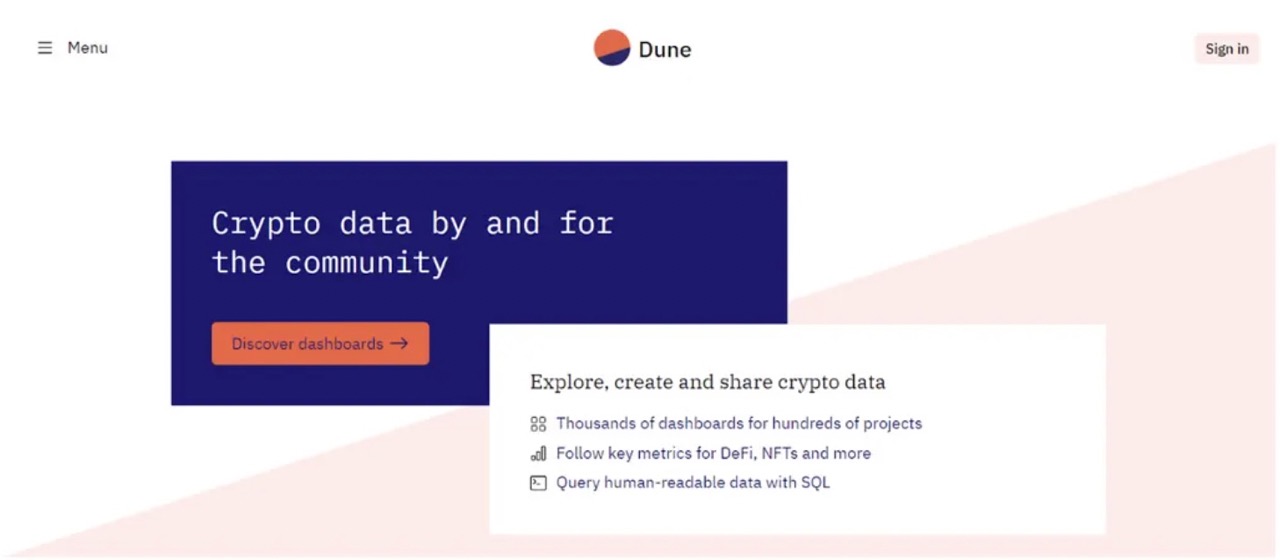
 Pros
Pros
- Free version available
- Supports data query
- Copy existing dashboards to customize with your own data
 Cons
Cons
- Difficult to use for newbies
- New dashboards require SQL knowledge
- Pricey upgrades to Thug Life and Elite tiers
Key Features
Dune is a dream for DeFi fans. Imagine being able to pull protocol data right from the blockchain. Yeah, Dune dashboards can do that, but the process falls on the techy side of things. The good news is that someone has probably already built a dashboard that does what you need.
- Protocol-specific blockchain data: Want to know how much a protocol is making? Build a query, and Dune delivers the data. Put it in a chart or a table, or just display a single number. Dune uses SQL queries to pinpoint specific data.
- Search by name or tags: Dune doesn’t have a fancy screener, but you can find projects by name or by browsing tags. If there’s an existing dashboard, you can dig through the data or clone it and add your own queries.
- Whale hunting: This one may not be obvious, but if you find a dashboard for a project that shows the top wallet addresses that transact with the protocol, you can use a portfolio tracker like Zapper.xyz to see what else they’re holding. There might be a few hidden gems.
- Private dashboards: If you upgrade, you can build private dashboards, ensuring all those nosey DeFi peeps can’t see what you’re planning next.
Who Should Use It?
- Traders who can code: Dune builds new queries using Structured query language (SQL), basically a syntax used to pull data out of databases, or the blockchain in this case. If you’ve got some coding chops, you can be your own hero on Dune.
- DeFi investors: Crypto is like the wild west, but DeFi is more like Mad Max. It takes real data to cut through the hype, and Dune delivers. Even if you’re not a coder, there are probably a few dashboards already built for whatever you’re considering or have already bought.
- Crypto whales: Tools like Messari and others are good for the big picture, but if you’re betting big money, you want detailed reporting. Dune can tell you nearly anything you want to know from a revenue or user base perspective. And you’re not limited to the big-name cryptos and protocols.
What Sets It Apart?
Many research tools limit customizations. Sure, there are reports on this and that, but if you have a specific question and the data exists on the blockchain, Dune gives you the leverage to pry it free. This is techy stuff, but that’s the appeal.
How Much Does Dune Cost?
You can get started on Dune for free, and you can do more than you might expect on the free tier. Build a query, and save it to a dashboard. Add more queries to your dashboard. The only problem? It’s slower than the paid tiers — and none of your dashboards are private. Thug Life is $420 per month and gives you 4x faster queries with 2,000 executions per month and 10 private dashboards. Elite ($1,337 monthly) executes queries at 8x speed while giving you 4,000 executions per month and 100 private dashboards.
3. Glassnode: Best For Crypto Derivatives Traders
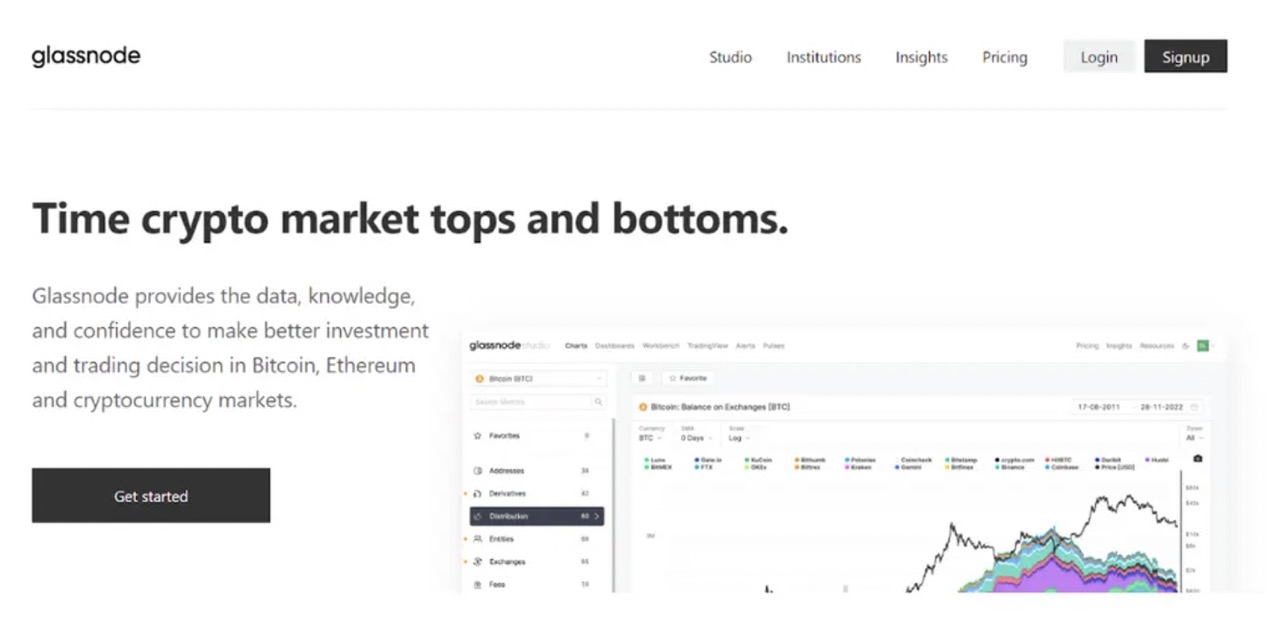
 Pros
Pros
- Free version available
- Integrated TradingView charts
- Detailed blockchain activity for blue chip cryptos
- API integration
 Cons
Cons
- Some features not intuitive for newbies
- Limited cryptocurrency choices
- Low alert limits: 1 on Free plan, 10 on Advanced plan
Key Features
Glassnode provides a clean interface with detailed reports for top crypto projects. Even free accounts can access charts and data for specific protocols. Want to know how many ETH there are after the merge? Build a dashboard, and Glassnode puts it on a chart you can track. Cool.
- Easy-to-use dashboards: Build a dashboard that stays up to date with data from the blockchain. Searchable filters make it easy to pull the numbers you need.
- Bitcoin and Ethereum futures market data: The futures markets can be a window into tomorrow’s crypto pricing, and BTC and ETH can move entire markets. Advanced plan users can track futures (and options) market metrics, including leverage ratios, open interest, funding rates, and more.
- Alerts: Build custom alerts to stay informed on market data. Want to know when big money is moving on Bitcoin? Set an alert. Just choose an asset and set the condition.
Who Should Use It?
- Blue-chip crypto traders: Glassnode brings you detailed reports and charts on a select group of cryptocurrencies. If you’re interested in top cryptos and leading DeFi projects, like Uniswap or Yearn, Glassnode can help you understand what’s going on with each asset.
- New crypto investors: Glassnode is easy to use, and you probably won’t even need to read the directions. You’re also limited to fewer cryptos you can research, which focuses newer investors on well-established projects and cryptocurrencies.
- Futures traders: If you trade BTC or ETH futures or options through a brokerage, you’ll want to upgrade to the Advanced plan on Glassnode so you can make informed decisions before taking a position. Analyze open interest over time, funding rates, and more.
What Sets It Apart?
Glassnode seems like a limited feature set until you start digging through the options. This research tool brings more power than meets the eye, pulling data directly from the blockchain. Want to track the active addresses on Aave? Easy. Build a dashboard in just a few clicks.
How Much Does Glassnode Cost?
You might be surprised by what you can do for free on Glassnode, but it won’t be long before you build a report you can’t view. Upgrading to the Advanced plan costs $29 per month when paid annually. The Professional plan costs $799 per month and gives you more history for key trading areas like futures.
4. Santiment: Best For Interactive Features
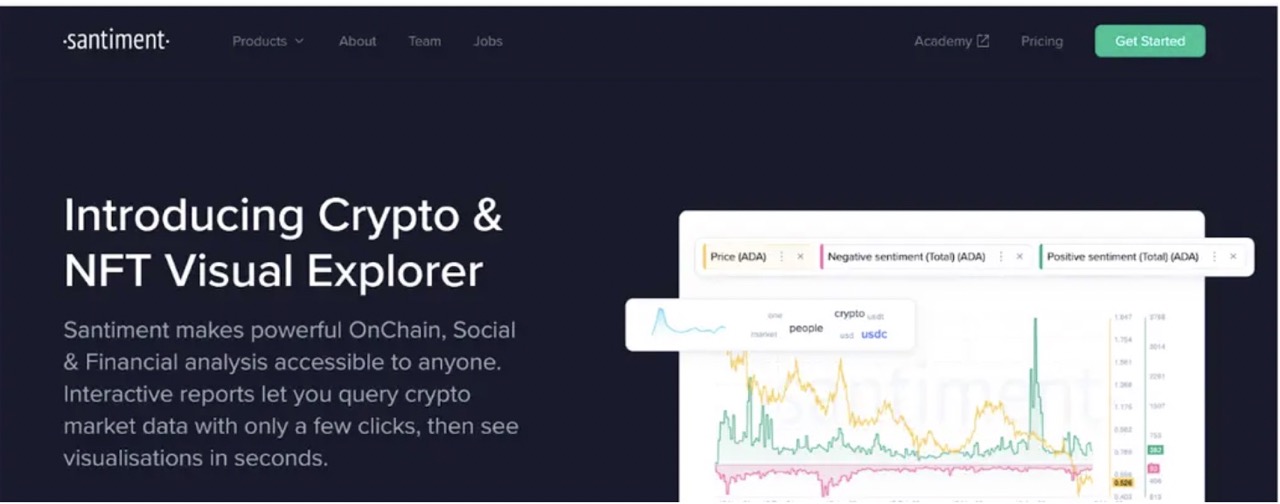
 Pros
Pros
- Free trial available
- Earn discounts for holding SANS tokens
- Screen with hundreds of filters
 Cons
Cons
- No token-specific research articles
- Higher plan cost
- 30-day data lag without upgrade
Key Features
What do you get when you mix the features of Dune with Messari? Well, it might look like Santiment, although Santiment is the prettiest of the bunch. You’ll get a powerful screener and the ability to run SQL queries to extract data from the blockchain.
- SQL Queries: Santiment brings an easier-to-use (but still not super easy) SQL query builder compared to Dune. Not a superstar coder? No problem. Santiment offers a training section with some pre-built examples.
- Social Cues: Find out what people are tweeting about or chatting up on Reddit and Telegram. You can also search by ticker to see where people are talking and when the buzz started.
- Screener: Let’s say you want to find altcoins for protocols that have grown in users by 100% or even 500% in the past week. Easy. Use the screener (upgrade required for some screens). Now, set a price limit, so you can find tokens that haven’t already had their run. Add your picks to a dashboard and explore additional metrics, like the percentage of whales that own the supply or the total number of holders.
Who Should Use It?
- Intermediate and pro crypto investors: Santiment has a bit too much going on to say it’s newbie-friendly, but it’s not super hard to use, either. Still, the tools and screens available are better suited to people who’ve been through a market cycle or two.
- People who trade often: Santiment’s social data makes it ideal for traders who want to know what the latest twitterings are about. Spot a niche or a particular token and build a dashboard to track the metrics before jumping in (or out).
- Selective investors: You’ll have to upgrade to get the best filters, but Santiment’s screener is powerful and covers over 260 assets, including categories like ERC-20 tokens or DeFi tokens.
What Sets It Apart?
Santiment is powerful while still offering features for average users. We found the screener to be intuitive and loved the way you can click through to the results and start building a detailed dashboard of stats. Santiment lets you make informed trades.
How Much Does Santiment Cost?
There’s a free tier, but some of the data is 30 days behind. It’s like a free peek at what you could do if you open your wallet and upgrade. The Pro plan costs $49 per month ($44 if billed annually), while the Pro+ plan costs $249 per month. Santiment’s Pro plan likely meets the needs of most traders and comes with full historical and present-day data along with 20 customizable alerts.
5. IntoTheBlock: Best For Professional Traders
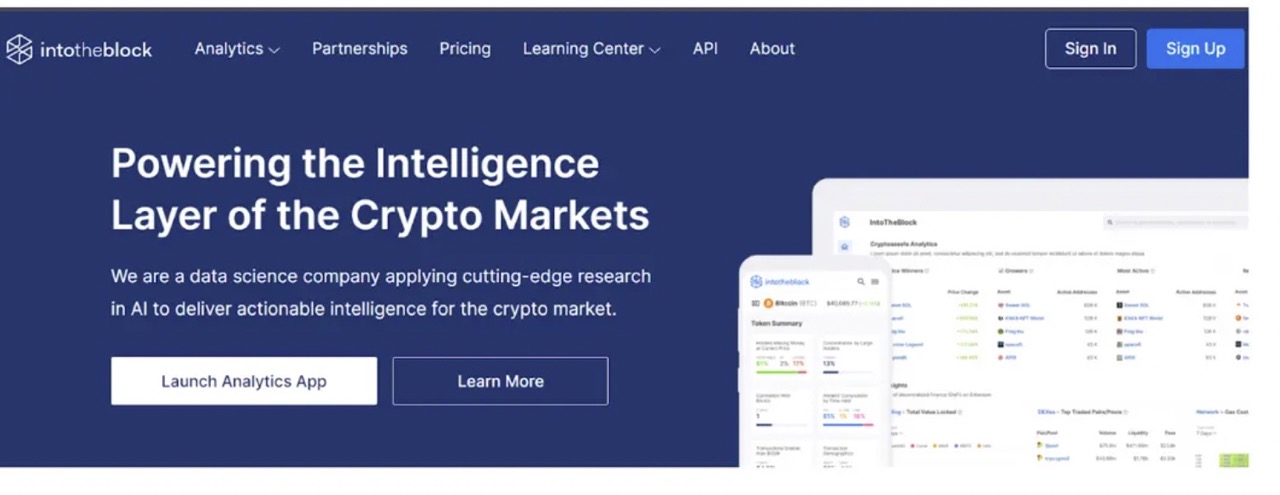
 Pros
Pros
- 7-day Free trial available
- DeFi deep dives
- Bitcoin and Ethereum market signals
- Hourly price direction predictions
 Cons
Cons
- Limited coin and token support
- No screener
- Incomplete DeFi section
Key Features
They had us at price predictions. Every hour, IntoTheBlock serves up piping-hot price direction predictions for top cryptos. The current track record for Litecoin is 61% accuracy, which may not seem high, but Vegas was built on lower odds than that.
- Blue-chip DeFi intelligence: Get at-a-glance data on the top DeFi protocols. View market-wide data or do a deep dive into protocols like Uniswap or Compound.
- BTC and ETH analytics: Want to know what percentage of Bitcoin holders are in the money? It’s 70% as of this writing. IntoTheBlock has a handy summary with helpful stats. But there are also over 50 signals and indicators to help you gauge the next moves.
- Price predictions: These are just fun. IntoTheBlock serves up hourly predictions based on market indicators, and the hit/miss ratio isn’t bad on some coins.
Who Should Use It?
- Blue chip DeFi investors: IntoTheBlock excels in two areas, one of which is analysis of the top DeFi hot spots. If you want to know what’s going on with Curve or Uniswap, you’ll probably find the stats here.
- Bitcoin and Ethereum investors: This is the second standout niche for IntoTheBlock. You won’t find the latest weird token they’re talking about on Twitter. What you will find is more market signals for BTC and ETH than you thought possible.
- Beginner investors: Combine a low monthly cost, an easy-to-use platform, and a focus on blue-chip cryptos — and now you have something people new to crypto can use to learn and grow.
What Sets It Apart?
There are no fancy screeners or SQL queries, just blue-chip DeFi with a sprinkling of Bitcoin and Ethereum market signals. At $10 per month, most traders can afford to give IntoTheBlock a try, but there’s also a free 7-day trial with no credit card required.
How Much Does IntoTheBlock Cost?
This platform is simple in every way. There’s just one tier: $10 per month.
6. Nansen: Best For Non-Fungible Tokens (NFTs)
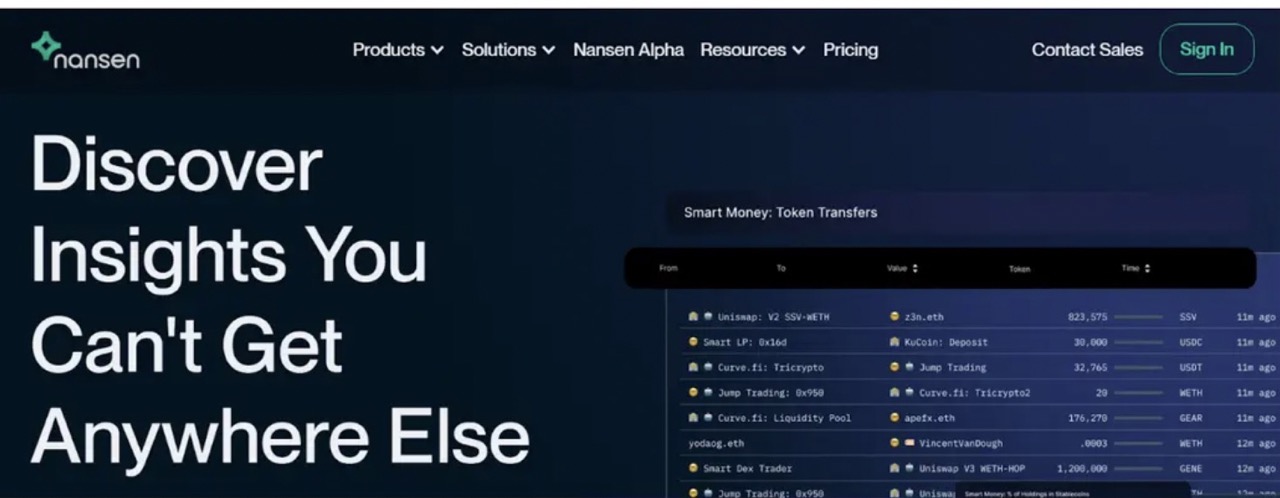
 Pros
Pros
- Follow the smart money
- Set alerts on wallet actions
- Find upcoming NFT mints
 Cons
Cons
- Spendy
- Limited support for Layer 2 DeFi
Key Features
What if there was a way to automate spying on smart money wallets? That’s what Nansen does (among other things). You can set alerts when whales transfer or buy (or sell) or when new NFTs are minted. Get ’em while they’re hot. And it’s all on-chain, which means the data is fresh, so you can beat the stampede.
- Smart Money Wallets: Nansen screens wallets to be featured in the Smart Money Wallets section. These are crypto peeps with significant assets, who are probably a better-guiding light than the crypto creep DMing you on Twitter. Watch out, though: people send scam tokens to whales, so not everything they hold is a gem.
- NFT Sales Data: Blur isn’t the only place to find NFT sales stats. And — you guessed it – you can spy on the Smart Money wallets to see which NFTs they’re buying and selling.
- NFT Latest Mints: Hot NFT collections often go up at resale. Nansen lets you explore upcoming mints. There’s also an NFT snipe tool so you can beat other traders to the draw.
Who Should Use It?
- NFT investors: Nansen isn’t cheap, but neither are the best NFTs. Many of Nansen’s features center on finding and buying premium NFTs.
- Pro investors: Intermediate investors can also benefit from Nansen data, but pricing for the service is unapologetically high. Pro investors can earn back their investment and much more just by investigating the moves of smart money wallets. The blockchain holds no secrets and tells no lies.
- DeFi Investors: There might not ever be another Bitcoin, but there could be another Aave or Uniswap. Nansen’s DeFi Paradise highlights the hottest protocols and contracts in DeFi-Land.
What Sets It Apart?
Nansen centers on what the smart money is doing, gathering all the wallet addresses worth knowing about in one place. It’s up to you to do your own research, but you’re bound to discover something that wasn’t on your radar.
How Much Does Nansen Cost?
Nansen has three plans: $100 per month, $1,000 per month, and $2,000 per month, the last of which is by application only. The standard plan buys you access to the movements of 250 million wallets across more than 10 blockchains, all with tidy labels. Bring your detective hat.
7. TradingView: Best for Newbies
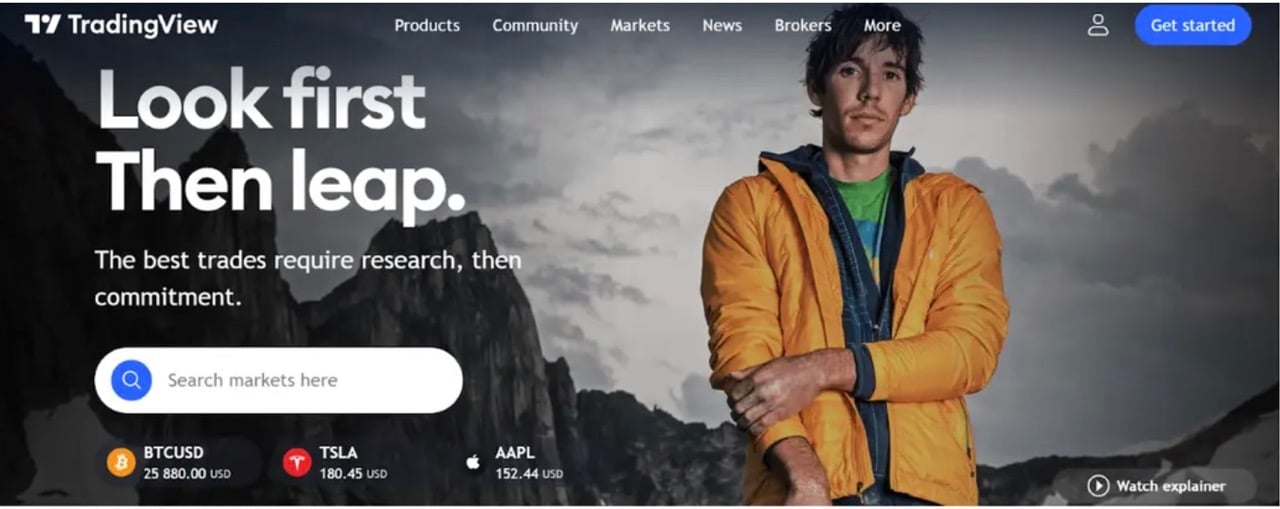
 Pros
Pros
- Superior charting
- Trading alerts
- Strategy backtesting
 Cons
Cons
- Limited crypto screener
- Busy interface
Key Features
Want to backtest your trading strategy? TradingView lets you do that and more, bringing detailed charts, alerts, hotlists, and more. This one was built for stocks but also supports many cryptos you’ll find on exchanges.
- The best charts out there: If you’re a technical trader or aspire to be one, TradingView belongs on your list. Other tools may be better for finding new NFTs or scanning for DeFi tokes, but TradingView is all about the charts.
- Backtesting: Testing a chart-based trading strategy can be costly when you’re trading live with real money at stake. TradingView takes the burnt-wallet smell out of strategy testing by instantly telling you if it would have worked in the past. Awesome.
- Cryptocurrency market: TradingView’s crypto section shows you a snapshot of the market and lets you drill down to find winners. Check the top movers or find the cryptos ripe for a reversal based on oscillators (chart signals).
Who Should Use It?
- Traders: You don’t have to be a pro trader to appreciate TradingView, but you’ll get more out of it if you have a better understanding of charts and indicators. TradingView’s chart section looks like an artist’s palette, ready to paint nearly any type of indicator you could need on your canvas.
- Beginner and intermediate crypto investors: TradingView’s goal is to make you a better trader. That’s why they built a massive community center with hundreds of articles and videos to help you improve no matter what your level of expertise.
- Amateur (and pro) coders: If you always wanted to learn to code but didn’t see the point in another “hello world” Python program, give TradingView’s Pine script a whirl. You can create custom indicators and run them on the TradingView platform.
What Sets It Apart?
TradingView is all about trading and charts. There’s a simple screener, but the real strength of the app is in its ability to add just about any kind of indicator you could need. You can also backtest trading strategies based on indicators — a feature that could pay for the subscription cost many times over.
How Much Does TradingView Cost?
Pro Pricing starts at $12.95 per month for 5 indicators and 40 monthly alerts. The Pro+ and Premium plans are $24.95/month and $49.95/month, respectively. Each upgrade tier boosts the number of indicators you can use and the number of alerts.
8. CryptoQuant: Best for Algorithmic Traders
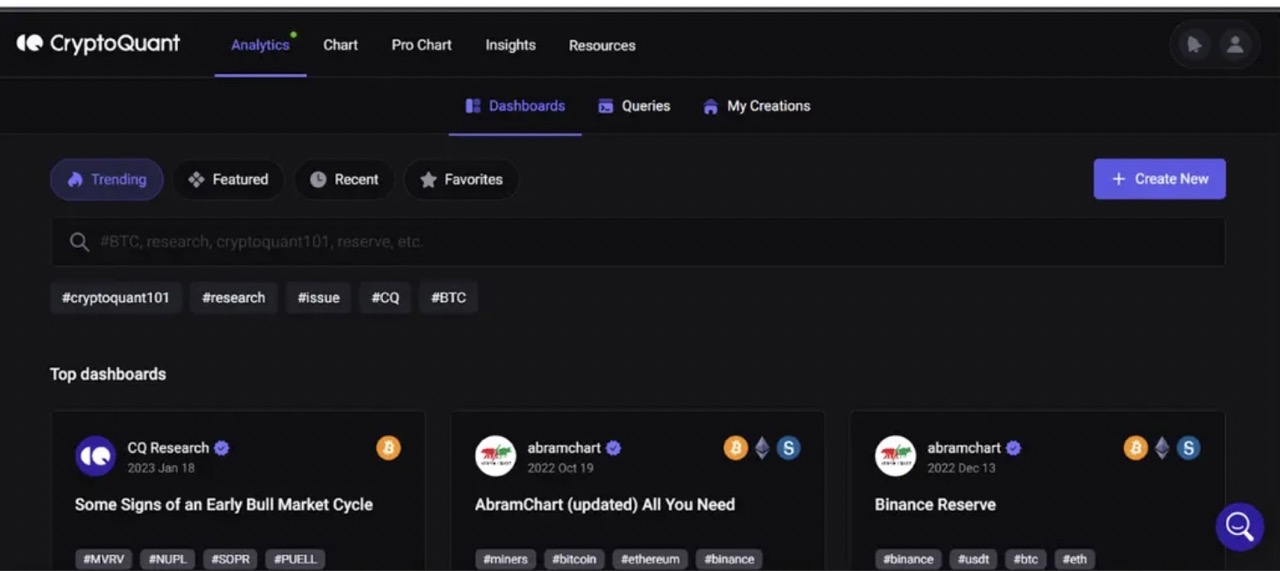
 Pros
Pros
- Charts for dozens of metrics
- Trading alerts
- Custom blockchain queries
 Cons
Cons
- Not beginner-friendly
- Higher monthly cost
- Limited token support
Key Features
CryptoQuant brings up-to-date data for top cryptos and ERC-20 tokens. The platform centers on analytics, meaning it scans on-chain data to provide market signals – with handy tooltips that help you make sense of it all. You can also build your own blockchain queries with no coding knowledge required.
- Track money flows: Are whales moving money? Have exchange reserves changed? CryptoQuant knows the answers and shows you the data in detailed reports.
- Blockchain queries: Use the queries built by others or build your own. CryptoQuant provides a query builder that doesn’t require coding.
- Data monitoring with alerts: Set triggers and get notifications if certain conditions are met, like exchange inflows or outflows, changes in leverage ratios, and dozens of other metrics.
Who Should Use It?
- Analytical traders: Other crypto research tools give you price charts. CryptoQuant gives you charts you didn’t know existed. Want to compare the Bitcoin spot market to the derivatives market? There’s a chart for that — and much more.
- Investors trading large positions: CryptoQuant offers more than average traders may need. But when you’re trading in size, the big-picture approach of CrytpoQuant is welcome when you have to make a trading decision. This isn’t a “sell because the chart said so ” app. Instead, you’ll see all the puzzle pieces so you can plan accordingly.
- People who think like programmers: You don’t need programming skills to build queries on CryptoQuant, but it helps to think like a programmer. The query builder follows a logical path, letting you select which tables to query and which data you want.
What Sets It Apart?
CryptoQuant provides more detail on market factors that can affect your crypto investments. Compare US exchanges to overseas exchanges, pull mining and supply data, or even build your own custom query. You can also view the output of queries built by other traders.
How Much Does CryptoQuant Cost?
The Advanced plan starts at $29 monthly if you pay for a year or $39 with monthly billing. Professional and Premium plans cost $109 monthly and $799 monthly, respectively. There’s also a feature-limited free plan (with delayed data) that lets you take CryptoQuant for a test drive.
Who Should Use Crypto Analysis Tools?
- People who trade often: If you’re looking to maximize trades, the right tools can give you an indication of the best time to enter or exit your position.
- Institutional investors and people who trade in size: When there’s more at stake, it helps to have data to support your trading moves. Crypto is volatile, but research tools can take the guesswork out of big trades.
- People looking for their next investment: Some of the research tools we covered offer screeners, so you can find cryptos and tokens that match your criteria. Some even let you peek at the crypto wallets of large wallets. You might get a few research ideas there as well.
- People who DYOR: Crypto research tools offer ways to analyze markets, and some even provide exclusive research on certain assets and trends. But these tools are best suited for people who dig for more information before investing. A healthy curiosity will help you get the most out of whichever tool you choose.
How Do They Work, Exactly?
There’s a crypto research tool out there for everyone, and that’s because there’s such a wide gamut of tools available. Some are geared towards chart-based trades, and others pull everything you could ever want to know from the blockchain.
In fact, that’s how most work. Many crypto research tools use Structured query language (SQL) to bring in blockchain data. Basically, it’s a specialized language that looks at tables of data and then displays the information you need. It might be raw numbers, or it might be a chart, so you can compare it against other data or see movements over time.
When comparing against super-detailed tools, such as CryptoQuant, you could spend days or weeks finding the same data yourself, by which time it would be out of date. Tools are better. But that’s also why you have to pay to upgrade to access certain features.
What To Look For When Choosing A Crypto Intelligence Firm
Some of the cryptocurrency research tools in our roundup aren’t firms, per se. Instead, they’re apps. In many cases, you’re not paying a fancy firm for a detailed research report. You’re pulling live data from an ever-growing blockchain. In exchange, you’ll pay monthly or annually for access. A few offer analyst reports as well — although these often focus on larger sectors and markets.
Here are some things to consider before you click the shiny button.
- Cost: At the high end, crypto research tools can cost thousands per month. Look at pricing as a percentage of your portfolio. That’s a headwind you’ll have to overcome with profitable trades.
- History and reputation: Did the tool just launch? Is the interface riddled with “coming soon” signs? It may be wiser to use a well-established platform for your crypto research. Do a bit of research on their cancellation policy and general reputation as well.
- Available tools and reports: Some tools are overkill for average traders. Others don’t do enough if you’re working with larger amounts of money. Consider your needs carefully before committing to a long subscription. If you’re only 90% sold, a monthly subscription gives you an exit strategy if you find you need more tools and data (or fewer).
- Analysts: Some research tools, like Messari, do provide analyst takes on markets. It’s always wise to base big trading decisions on multiple data points, but if you’re reading analyst takes, check their credentials and background. Messari provides an author box next to research articles.
Benefits Of Using An Analysis Tool
Many crypto research tools still have a DIY element, but you’ll get access to information that’s difficult to compile on your own.
- Up-to-date data: For tick-by-tick data stock trading data, you need a brokerage service. Crypto is similar. Many free crypto research tools delay data – sometimes by as much as 30 days. Using a paid research firm or app gets you the real-time data you need to make informed trading decisions.
- Charts: Crypto-specific charts can be hard to find, and when you need more than just price charts, almost impossible. Crypto research tools can provide charts for nearly anything you want to visualize, so you can see the trends.
- Industry insights: Maybe you’re a doctor or a lawyer, or a teacher. You’re an expert in your field because you’ve been training for years. Many platforms offer industry insights from experts in the crypto industry and related markets. Like you, they live their job and can bring unique insights to those of us on the outside looking in.
Risks
- Sometimes large financial commitments: Most plans let you pay monthly, with the ability to cancel. If you choose to pay annually to get a discount, be sure the plan fits your needs.
- Investment headwinds: If the annual cost of a crypto research tool is 10% of your portfolio value, you’ll have to make more than 10% to get ahead. In effect, it works like a management fee – but you make the trades. Higher cost plans create a deeper hole, but it’s important to weigh the cost in comparison to your investment and potential gains.
- Varying analyst takes: It’s tough to get 10 analysts to agree on anything. If some analysts fall on the bearish side and the rest on the bullish side, someone is wrong, and probably more than one. Always do your own research in addition to reading analyst takes.
Frequently Asked Questions
There really isn’t a single “best” crypto research site. Instead, there’s a best research site for your specific needs. TradingView is great for charts and indicators. Messari brings industry experts and detailed supply information. Dune and Santiment let you build your own blockchain queries so you can customize your analysis.
Before you invest in any token, read the whitepaper to understand its technical details and why it exists. Then, research the team behind the project and weigh the real-world market for the project. The research tools covered above can help you find crypto projects to research and often provide detailed information on price, sentiment, supply dynamics, and more.
On most charts, a green candle represents a price increase, and a red candle represents a decrease. You can adjust the date to monitor price movements across any time frame you want. Tools like TradingView offer extensive help sections and community content to help you get the basics down before you start trading. On TradingView, you can even backtest your chart-based trading ideas.